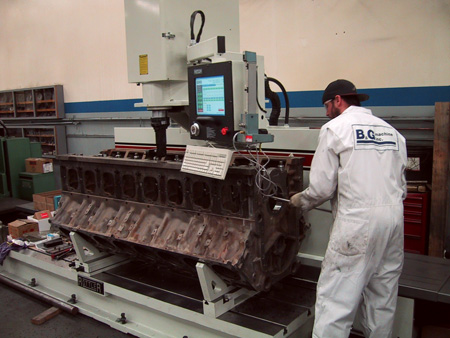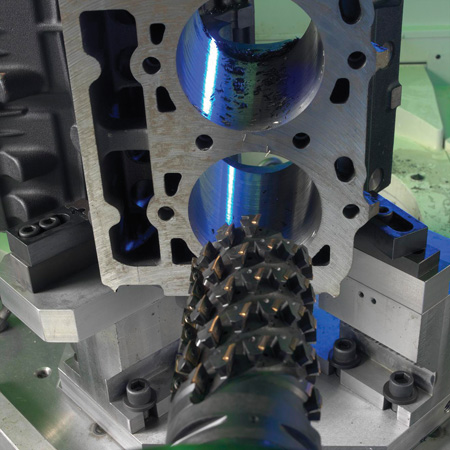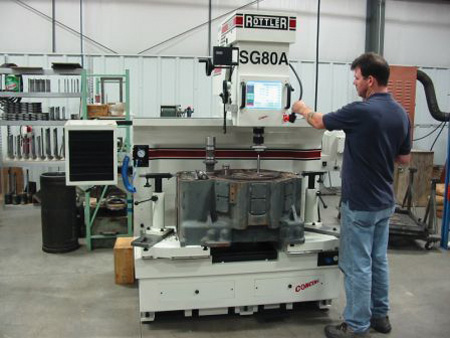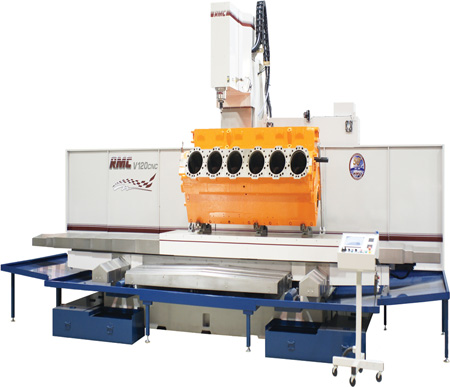On one hand, automating certain commonly performed machining processes means you only have to do the initial setup once and the machine does the rest. It frees up the machine operator to do something else, and it reduces the risk of human error when doing tedious, repetitive tasks. On the other hand, making the transition from traditional manually operated machine tools to CNC equipment requires a substantial investment in new equipment, and learning how to program and operate the new equipment.
CNC machining centers that are capable of working on large heavy-duty diesel engines and industrial engines typically cost of at least $225,000, and can cost hundreds of thousands of dollars depending on the capabilities of the machine and the tooling and fixturing you buy with it.
Buying or leasing CNC equipment is a serious, long-term financial commitment. That fact alone scares away many would-be buyers who would like to buy a CNC machining center, but aren’t sure they can afford it. Consequently, they often end up buying somebody else’s used manual equipment with the dream of someday upgrading to CNC.
That decision can be a big mistake in today’s market. There’s a glut of older, used manual shop equipment for sale right now because of the overall decline in engine rebuilding activity. Shops that go out of business put their equipment up for sale. The prices are usually a bargain, so shops that want to replace worn-out equipment or expand their capabilities buy these older machines rather than buying new. It saves money but it doesn’t do anything to improve quality, consistency or productivity.
To stay ahead of the competition today and keep abreast of the latest changes in OEM engine technology, shops that want the high dollar heavy-duty diesel and industrial engine work need equipment that is up-to-date, fast and accurate. That doesn’t necessarily mean CNC equipment in every case, but to be productive and to produce the kind of tolerances and finishes that many of these big engines require, CNC is the best alternative.
What Is CNC?
CNC is simply a means of automating the feed rate, cutting speed, location and angle of the machine tooling. The hand controls on a machine are replaced by servos that are operated by a computer. The operator tells the machine what he wants to do by typing on a keyboard or using a touch screen (such as bore the block, cut the upper and/or lower O-ring seats for the cylinder liners, align bore the block, resurface the block, etc.).
The operator also enters the necessary parameters that tell the machine how much metal to remove. The block is then located manually or automatically with respect to the tooling, and the computer takes over to run the equipment and perform the desired processes.
So what happens if the operator enters the wrong information or doesn’t mount the work piece correctly? Much of today’s CNC equipment has built-in safeguards in the software that is capable of detecting input errors, location and tooling errors and will stop the machine and/or ask for corrections before
proceeding.
Programming is the key to CNC machining. That’s the part that intimidates many people who are fascinated with the capabilities of CNC machining, but who are not comfortable with computers. CNC machines can be extremely accurate and perform one automated process after another on the same engine, or on a whole series of engines with no human intervention or babysitting.
Contrary to popular misconception, CNC is not just for high volume manufacturing or production engine builders. You can use CNC on any application where you need to perform the same process over and over again. It’s also better than manual equipment for repeatability, consistency and accuracy.
A CNC machine can do a whole row of cylinders on a V16, with each one cut exactly the same as the next, and typically do it in half the time of manually operated equipment.
With right angle cutting tools, a CNC machine can reach into areas and machine surfaces you can’t do with manually operated equipment, such as cylinder bores where the lower step bore for the liner may be larger than the upper step bore. The tooling can also reach inside the ends of large hydraulic cylinders to recut the ID to accept new seals. That’s something you can’t do manually.
CNC machining can refinish a series of water jacket openings, lifter bores, soft plug openings or o-ring port areas with amazing consistency and accuracy, while saving time and reducing the risk of a comeback because the job wasn’t done right.
CNC can also replace hand grinding as when refinishing a combustion chamber that has been furnace welded. The machine can be set to refinish each combustion chamber exactly the same, so there is no variation in compression ratio cylinder-to-cylinder.
CNC requires input commands that tell the controls how to move the tooling. In a 3-axis machine, the X, Y and Z coordinates correspond to in and out, left and right, and up and down. That’s basically all you need to machine a big engine block.
If you want a CNC machine to automatically repeat the same process for one bank of cylinders on a V-block, and then rotate the engine to do the other, you need a 4-axis machine (the 4th axis is rotation of the workpiece).
For fancy stuff like porting cylinder heads, the workpiece and tooling head both have to move so the tooling can follow complex curves and circular motions to achieve the desired results. This requires a 5-axis CNC machine (the 5th axis being the circular movement of the tooling).
If you’ve ever watched a CNC machine porting a cylinder head at a trade show or in a shop, it’s amazing how complex the gyrations of the workpiece and tooling can be. The motions are carefully choreographed so the tooling removes metal in exactly the right places. Figuring out how to program such intricate movements requires a fair amount of CNC know-how as well as software that can translate the desired results into actual machine tool movements.
For those who are programming CNC machines manually, that means learning G-code (the programming language of CNC machines). Various G-code commands correspond to various tooling movements in the X, Y and Z planes. Each line of G-code tells the tooling where to move, how quickly to move and at what angle so metal is removed where it is supposed to be removed. A lot of trade schools offer courses in G-code and CNC programming, and training materials are also available online.
But all of this really isn’t necessary if you buy a CNC machine that has control software designed for an automotive machine shop environment. Though many of the big industrial CNC machines require programming skills, others do not and are relatively quick and easy to learn.
Anthony Usher of Rottler Manufacturing says his company has strived to make CNC machining as easy as possible for its customers by eliminating the need for complicated keyboard inputs and programming. “We use a touch screen for entering all the machine commands, with buttons for basic jobs such as boring the block, resurfacing the block and so on. All the programming has been done, so all the operator has to do is tell the machine what he wants it to do and the machine does the rest.”
Rottler provides on-site training for its CNC customers, which typically takes several days to a week depending on how many employees need to be trained.
Rottler’s CNC machine for heavy-duty diesel and industrial engines is the F90Y, which is a 3-axis machining center. The software is based on Windows XP and the controller is an industrial-grade PC with Intel processor. The equipment can also be used with full CAD/CAM (Computer Aided Design & Manufacturing) software for unlimited machining capabilities, too.
Ray Meyer at RMC said his company’s flagship CNC machine for handling big engines like the 3516 Caterpillar and 7042 Waukesha is the V120 5-axis machining center, though it is usually sold in a 3-axis configuration for doing this kind of work. The control software is the same as that on their V30 CNC machine, and is menu driven with conversational inputs for ease of use.
Meyer said the demand for big CNC equipment today is being driven by the energy business and the military for repairing large generator and pump engines.
Meyer said CNC equipment is more affordable than one might think. “If you buy a machine that costs you $3,500 a month, you can usually pay for the equipment with one job a month. For example, some shops charge $4,000 to do the upper and lower sleeve repairs on a 3516 Caterpillar engine. So any jobs you get beyond that would be in the black.”
Haas Automation, Mazak, Makino and Milltronics are other companies who sell industrial grade horizontal and vertical CNC machines that can be used for reconditioning heavy-duty diesel industrial engine blocks. Some of these machines cost up to three-quarters of a million dollars, so they’re not for everyone. This type of equipment is typically used in OEM production facilities.
First-Hand Experience
David Bianchi of B&G Machine in Seattle, WA, said he bought his first CNC machine nearly 20 years ago. “CNC enabled our business to expand and prosper,” he said. “We now have a number of CNC machines in our shop, and just recently installed two Rottler F99Y 3-axis machines.”
Bianchi says the CNC equipment is easy to set up and use for a wide variety of jobs. “On 3500 cylinder blocks, we often have to do water jacket repairs. We used to machine out the damaged areas with an end mill and install inserts. Now we do all 96 holes automatically with our CNC machines.
“One thing you have to keep in mind when machining heavy-duty diesel and industrial engines is your liability. These are expensive castings and there’s no room for error. You have to be consistent and do high quality work.”
We asked Bianchi about the maintenance, reliability and return on investment on his CNC machines. He said the units are self-lubricating, and other than occasional spindle checks and adjustments, no special maintenance is required. “In the last 20 years, we’ve had maybe 2 days of down time on our machines. They are very reliable.”
A shop’s return on investment will depend on the type of work they are doing and how much they charge. Most of the repairs on large diesel and industrial engines are fairly expensive, so the payback comes fairly quickly – assuming you have the work to support your investment. It’s not as competitive as automotive engine rebuilding and the margins are better. Even so, a shop has to do top quality work to protect its reputation, he said.
Rex Crumpton Jr. of Memorial Machine in Tulsa, OK, has been using CNC equipment since 1984. “We use several different machines, and our CNC lathes that use G-code inputs require a highly skilled operator to run. But our Rottler machines are much easier to set up and run.”
Like others who have made the transition to CNC machines, the advantages of CNC (speed, quality & accuracy) have allowed Memorial Machine to grow and prosper.
Buying a CNC Machine
If you think you might be interested in buying a CNC machine, the best advice we can give you is to talk to others who are using CNC machines in their shops to find out what their experiences have been with this type of equipment.
Is their equipment easy to set up and run, or does it require special training in CNC programming and G-code?
How long does it take them to set up and run common processes? Is it faster than manually machining the parts?
What kind of results have they been getting with their equipment? Is it more consistent or higher quality than what they were getting with manual equipment?
Have they had any problems, such as equipment down times or tooling issues? If so, how quickly and easily were these problems resolved? Was their equipment supplier helpful and responsive?
Once you have this information, you need to ask yourself several questions before you decide to buy anything:
1. What exactly do you want a CNC machine to do for your business? Do you want to reduce your manual labor costs? Do you want equipment that can do jobs that your existing equipment can’t handle? Do you need to upgrade your quality and consistency to retain your customer base? In other words, what’s your rationale and game plan for buying a CNC machine?
2. How many jobs (and at what price) will you have to do every month to pay for the equipment? Do you have the volume of work now to pay for new equipment, or is there significant potential for expanding your customer base so you can take on more work to pay for the equipment?
3. Who will operate the equipment, and are they capable and comfortable with the notion of learning how to operate a CNC machine?
Right now, it’s a buyers market. If you have been contemplating a major equipment purchase such as a CNC machine for big diesel work, or even passenger car and light truck engine work, you can probably negotiate a better deal today than if you wait for the economy to inevitably turnaround.
President Obama wants to spend billions of dollars on road construction and other major infrastructure projects to create jobs. This type of work requires lots of heavy diesel equipment, and the more work that’s done, the sooner these diesel engines need repairs. Shouldn’t you be ready for that work when it comes with new CNC equipment?
















